IDA 59
Russian Rebreather and the link to radioactive chip shops!
BACK
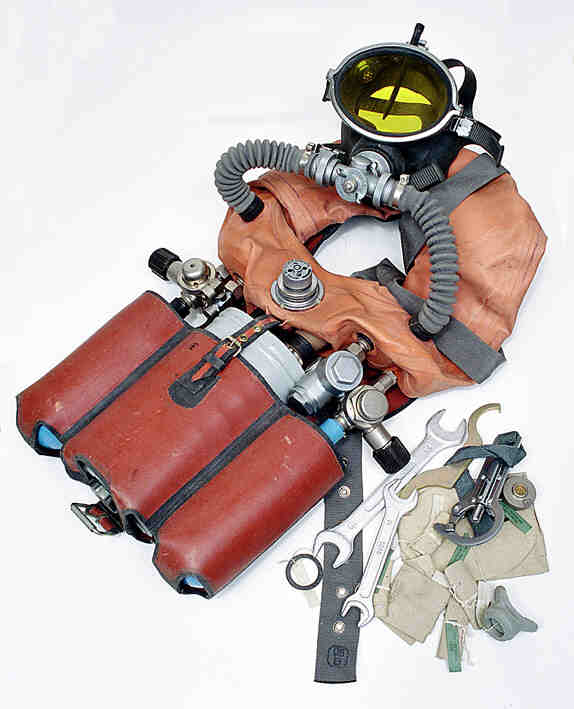
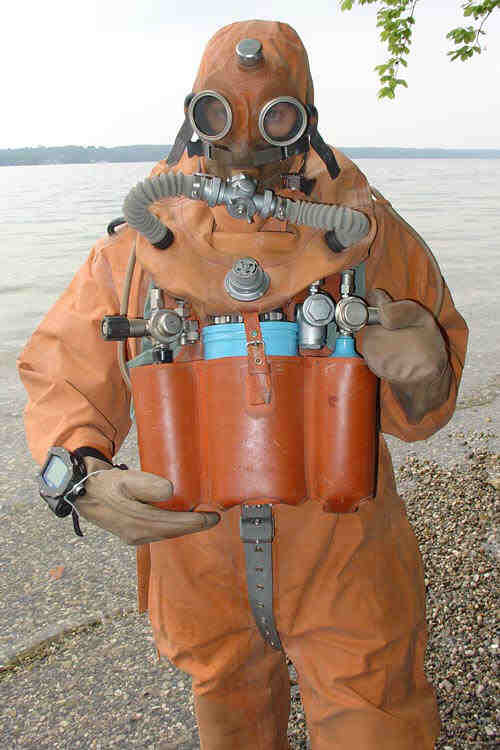 I
bought this Russian made IDA59 rebreather a few weeks ago on the internet. It
caught my eye because it was bundled together with the highly unusual and
original submarine escape suit. After doing some homework I found that this
rebreather was used on the deepest ever real life submarine escape in July of
1989. The stricken sub had caught fire and sunk taking with it almost the entire
crew. Six officers rode the emergency escape pod up from over 600 metres deep
wearing the IDA59 units. When the pod reached the surface, rough seas caused it
to fall over and it sunk back down. Only Warrant Officer Slyusarenko survived
the deep escape. Before this tragedy the submarine was a top secret prototype
powered by two hybrid nuclear reactors and sported a completely titanium hull.
Its name was Komsomolets which means “member of the young communist league”.
This submarine was much faster and capable of diving to deeper depths than
anything in the US arsenal at the time. The Komsomolets currently sits broken in
the Barents Sea over 1 mile beneath the surface. Shortly, everybody will know
the name of this sub as it becomes possibly the
I
bought this Russian made IDA59 rebreather a few weeks ago on the internet. It
caught my eye because it was bundled together with the highly unusual and
original submarine escape suit. After doing some homework I found that this
rebreather was used on the deepest ever real life submarine escape in July of
1989. The stricken sub had caught fire and sunk taking with it almost the entire
crew. Six officers rode the emergency escape pod up from over 600 metres deep
wearing the IDA59 units. When the pod reached the surface, rough seas caused it
to fall over and it sunk back down. Only Warrant Officer Slyusarenko survived
the deep escape. Before this tragedy the submarine was a top secret prototype
powered by two hybrid nuclear reactors and sported a completely titanium hull.
Its name was Komsomolets which means “member of the young communist league”.
This submarine was much faster and capable of diving to deeper depths than
anything in the US arsenal at the time. The Komsomolets currently sits broken in
the Barents Sea over 1 mile beneath the surface. Shortly, everybody will know
the name of this sub as it becomes possibly the
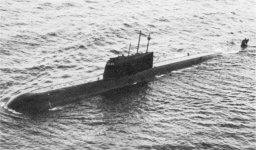 worst
environmental disaster the world has ever known. The Plutonium warheads and
reactors it harbours will eventually leak catastrophically. The fishing industry
in the arctic hemisphere will be decimated if the nasty stuff hits the fan. Even
better, there are five other atomic powered submarines lying crippled and
dissolving in deep water around the world.. Glow in the Dark fish and chips will
be the least of our concerns! Experts that studied this wreck site
initially thought that the immensely strong Titanium hull would protect the fish
from fallout for ever, but sadly this will not be the case. The reason
ironically lies in the construction of the submarine itself. Steel components
and alloys based on magnesium and aluminium corrode at enormous speeds in the
presence of titanium. The most recent studies show enormous hull breaches
already…oops!
worst
environmental disaster the world has ever known. The Plutonium warheads and
reactors it harbours will eventually leak catastrophically. The fishing industry
in the arctic hemisphere will be decimated if the nasty stuff hits the fan. Even
better, there are five other atomic powered submarines lying crippled and
dissolving in deep water around the world.. Glow in the Dark fish and chips will
be the least of our concerns! Experts that studied this wreck site
initially thought that the immensely strong Titanium hull would protect the fish
from fallout for ever, but sadly this will not be the case. The reason
ironically lies in the construction of the submarine itself. Steel components
and alloys based on magnesium and aluminium corrode at enormous speeds in the
presence of titanium. The most recent studies show enormous hull breaches
already…oops!
The IDA59 is a
closed circuit Trimix rebreather with a depth limitation of just 300metres! Made
in 1960 the pint sized unit is capable of adjusting gas flow rates automatically
while descending and ascending without any electronics. The user manual states
that non strenuous work can be achieved down to 90metres without taking any
additional tanks. It would take a braver man than I to go deeper than 10metres
with it without taking numerous bailout bottles! Its dinky scrubber canister has
an apparent duration of 2.5 hours, although I think the actual term the manual
uses was Life Expectancy. Russian rebreathers are known to use a binary
scrubber material called 03, this super oxide compound actually produces oxygen
as it absorbs exhaled carbon dioxide. That means that if you wanted to add some
jalapenos to your life you don’t need to fill the oxygen bottle at all.
Unfortunately if this chemical gets wet, the by product is so caustic that it
would burn through glass. The recent fire aboard the MIR space station was
started by the mishandling of this highly reactive compound.
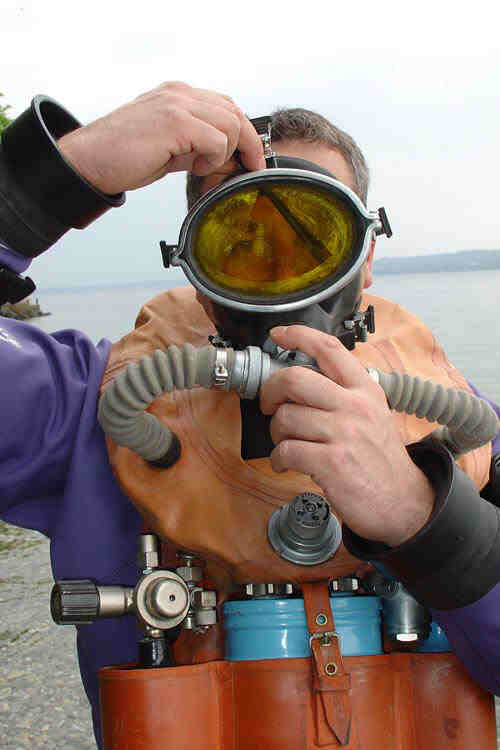 On
testing the unit, you immediately notice that only vertical swimming is
possible, the horse collar inhalation bag is placed in such a way that
horizontal movement is completely impossible unless you wear heavy anvil style
earrings. The trimix supply tanks on this little gem are small enough that you
can refill them, even with pure helium for under a fiver, the cost savings are
enormous. The money I have saved this week alone has paid for a new hanky sized
base jumping parachute and a 220 hp Suzuki Slingshot race bike. The escape
apparatus comes with a retro looking full face mask that screws directly to the
breathing loop. The mask even has a wiper blade that can be activated externally
to clean a fogged up face plate. Although it looks a bit Heath Robinson, it
works very effectively. The breathing valve or DSV (Dive Surface Valve) has a
setting that allows direct atmospheric air breathing even with the face mask on.
The unit is extremely robust and all the metal work is immaculate even though
over forty years old. A close up of the DSV with the hoses removed shows the
Russian version of a mushroom valve. In a western unit, these critical
components are made of rubber and shrivel to useless after a seasons diving, the
soviet design is a sprung piece of finely milled MICA glass plate. This
technique for directing airflow would have been prohibitively expensive, but
utterly reliable and crafted by top engineers from the cold war era.
On
testing the unit, you immediately notice that only vertical swimming is
possible, the horse collar inhalation bag is placed in such a way that
horizontal movement is completely impossible unless you wear heavy anvil style
earrings. The trimix supply tanks on this little gem are small enough that you
can refill them, even with pure helium for under a fiver, the cost savings are
enormous. The money I have saved this week alone has paid for a new hanky sized
base jumping parachute and a 220 hp Suzuki Slingshot race bike. The escape
apparatus comes with a retro looking full face mask that screws directly to the
breathing loop. The mask even has a wiper blade that can be activated externally
to clean a fogged up face plate. Although it looks a bit Heath Robinson, it
works very effectively. The breathing valve or DSV (Dive Surface Valve) has a
setting that allows direct atmospheric air breathing even with the face mask on.
The unit is extremely robust and all the metal work is immaculate even though
over forty years old. A close up of the DSV with the hoses removed shows the
Russian version of a mushroom valve. In a western unit, these critical
components are made of rubber and shrivel to useless after a seasons diving, the
soviet design is a sprung piece of finely milled MICA glass plate. This
technique for directing airflow would have been prohibitively expensive, but
utterly reliable and crafted by top engineers from the cold war era.
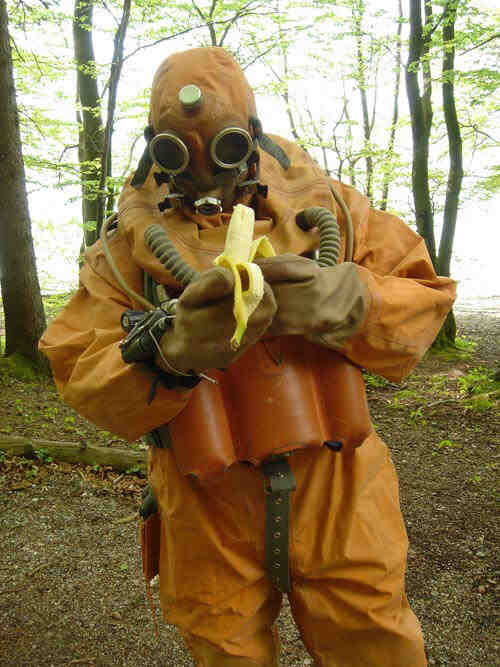 Today
I passed on wearing the wiper mask in favour of wearing the accompanying escape
outfit replete with monkey boy gimp hood. Wearing the orange escape suit with
integrated goggles would allow entry to any Conservative MP gentleman’s club,
guaranteed. There is no need for black plastic bags or oranges wrapped with
electrical flex with this set up at all. The baggy suit is designed for quick
donning, the kind of quick you need when you are on a smoked filled, rapidly
sinking submarine. Entry is achieved through a simple draw string closed front
access panel, the suit is complete with 3 finger gloves and would fit many
different body types. Pulling the Gimp hood over last, completes the ensemble. I
tried the suit for the first time in Lake Starnberg which is known locally as
the house reef of Munich, Germany. The water temperature was a Baltic seven
degrees and simulated conditions of a submarine escape at 300metres quite
realistically. On the right leg of the suit are two mini air tanks, akin to
large soda stream cartridges. The purpose of these was to give positive buoyancy
to the suit wearer once outside the crippled submarine. The whole outfit
including the rebreather is slim enough to allow escape even through the torpedo
tubes, unless you are a salad dodger of course. Ordinarily I would have tested
this emergency buoyancy devices strapped to my thigh. The book of words stated
that ascent speeds of 3 metres per second or 180 metres a minute were easily
achievable. I had only come up this fast before while attempting to slow down
open water students during ascent training.
Today
I passed on wearing the wiper mask in favour of wearing the accompanying escape
outfit replete with monkey boy gimp hood. Wearing the orange escape suit with
integrated goggles would allow entry to any Conservative MP gentleman’s club,
guaranteed. There is no need for black plastic bags or oranges wrapped with
electrical flex with this set up at all. The baggy suit is designed for quick
donning, the kind of quick you need when you are on a smoked filled, rapidly
sinking submarine. Entry is achieved through a simple draw string closed front
access panel, the suit is complete with 3 finger gloves and would fit many
different body types. Pulling the Gimp hood over last, completes the ensemble. I
tried the suit for the first time in Lake Starnberg which is known locally as
the house reef of Munich, Germany. The water temperature was a Baltic seven
degrees and simulated conditions of a submarine escape at 300metres quite
realistically. On the right leg of the suit are two mini air tanks, akin to
large soda stream cartridges. The purpose of these was to give positive buoyancy
to the suit wearer once outside the crippled submarine. The whole outfit
including the rebreather is slim enough to allow escape even through the torpedo
tubes, unless you are a salad dodger of course. Ordinarily I would have tested
this emergency buoyancy devices strapped to my thigh. The book of words stated
that ascent speeds of 3 metres per second or 180 metres a minute were easily
achievable. I had only come up this fast before while attempting to slow down
open water students during ascent training.
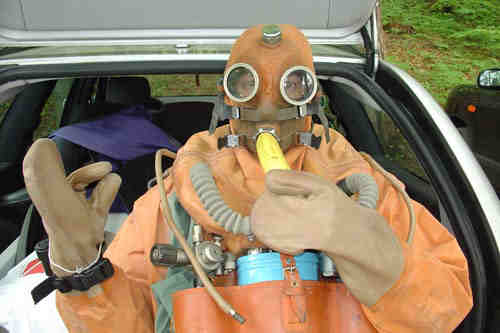 Putting
on all this equipment was hot and hungry work, it was time for lunch. Escaping
submariners would have been faced with the identical dilemma as myself today,
how to eat lunch through an orifice no wider than a pound coin? Someone with a
college degree would have bought soup and a straw to slurp it through, or even
Smarties. All I could manage for sustenance was a banana. Peeling the banana
with Bart Simpson fingers was difficult enough, pushing it through the mouth
hole gave me flashbacks to the Pulp Fiction movie scene where Zed wakes up his
leather clad buddy. After a disappointing and messy feed, it was time to road
test the escape suit. I gingerly shuffled through the trees that led to the
freezing lake. The suit was made of an extremely thin material and I had to put
my chunkiest under suit on underneath to keep the cold out. Every submariner
would be issued with such an escape suit. It was condom thin because it had to
roll up small enough to fit into the cramp crew quarters. Getting waist deep
into the frigid lake, I could feel my left leg rapidly becoming at one with the
water and realised the suit had a hole in it. A quick inspection found a thorn
stuck through the boot of the suit. I had walked next to some Holly bushes to
get to the waters edge and Mother Nature had dealt the suit a kidney punch. The
insides of Russian submarines must be very smooth places if this monkey suit can
be
Putting
on all this equipment was hot and hungry work, it was time for lunch. Escaping
submariners would have been faced with the identical dilemma as myself today,
how to eat lunch through an orifice no wider than a pound coin? Someone with a
college degree would have bought soup and a straw to slurp it through, or even
Smarties. All I could manage for sustenance was a banana. Peeling the banana
with Bart Simpson fingers was difficult enough, pushing it through the mouth
hole gave me flashbacks to the Pulp Fiction movie scene where Zed wakes up his
leather clad buddy. After a disappointing and messy feed, it was time to road
test the escape suit. I gingerly shuffled through the trees that led to the
freezing lake. The suit was made of an extremely thin material and I had to put
my chunkiest under suit on underneath to keep the cold out. Every submariner
would be issued with such an escape suit. It was condom thin because it had to
roll up small enough to fit into the cramp crew quarters. Getting waist deep
into the frigid lake, I could feel my left leg rapidly becoming at one with the
water and realised the suit had a hole in it. A quick inspection found a thorn
stuck through the boot of the suit. I had walked next to some Holly bushes to
get to the waters edge and Mother Nature had dealt the suit a kidney punch. The
insides of Russian submarines must be very smooth places if this monkey suit can
be 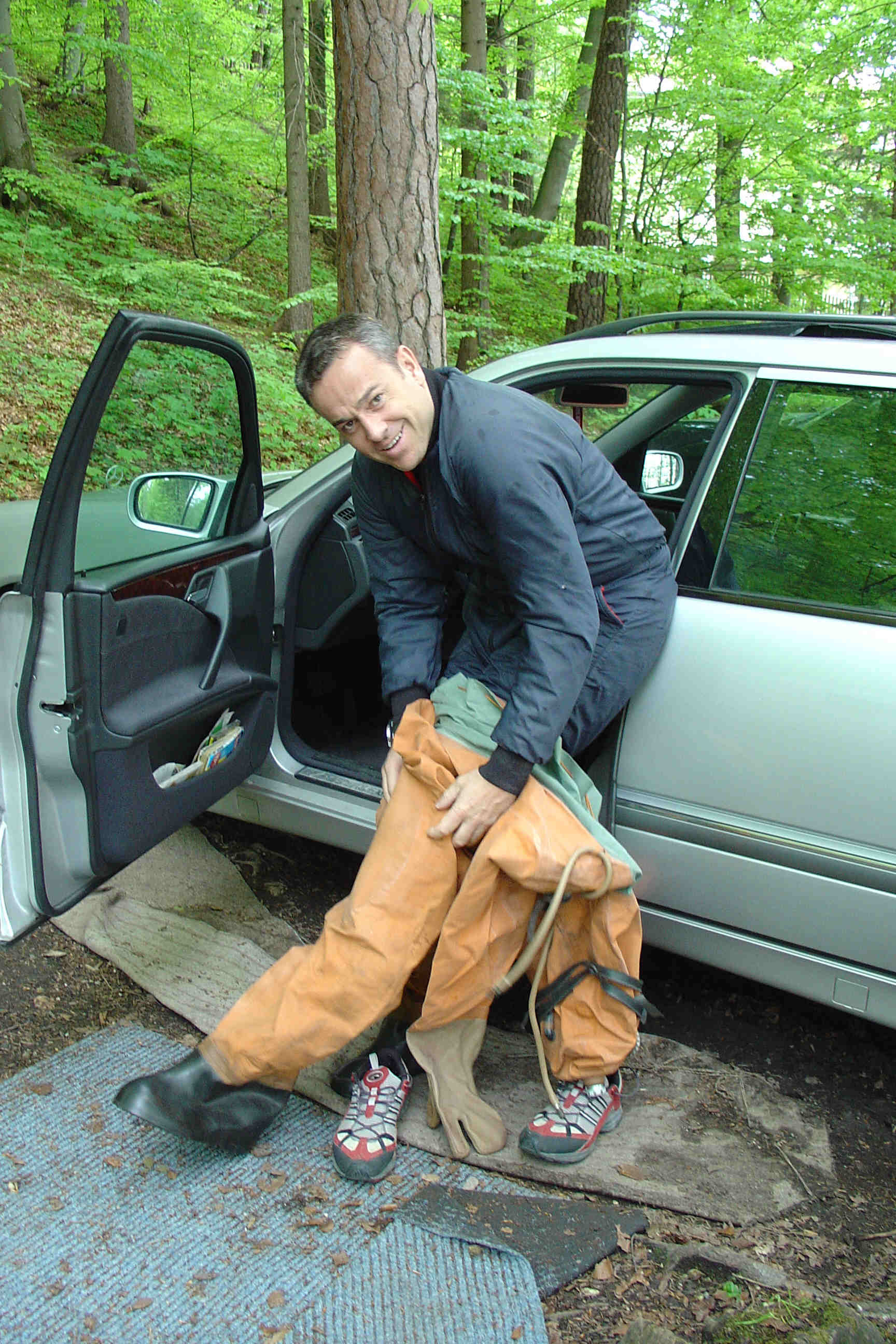 punctured
by a prickle bush. I conceded defeat and put my regular otter dry suit back on
and went for a dive just using the rebreather.
punctured
by a prickle bush. I conceded defeat and put my regular otter dry suit back on
and went for a dive just using the rebreather.
Considering the
age of the IDA59 rebreather, it is a truly remarkable piece of engineering. The
materials used in its construction will likely last another forty years. Quite
impressive when you consider modern scuba equipment is often broken or useless
after just forty dives. The escape suit was never really designed for bimbles in
a lake or cruising a reef, but would definitely take pride of place in any
diving equipment collection. You can follow the fate of the Komsomolets
submarine with its Plutonium tipped torpedoes and leaking nuclear reactors at a
fish and chip shop near you, that’s if the mad cow burgers or red food dyes
don’t get you first!
BACK
Wheres the Komsomolets now? - Project 685
Plavnik
The Project 685 was an advanced submarine developed to
test advanced submarine technologies. The submarine could carry a mix of
torpedoes and cruise missiles with conventional or nuclear warheads. The design
was initially developed in the 1960s, but the first unit was not laid down at
Severodvinsk until 22 April 1978. The submarine K-278 Komsomolets ["member of
the Young Communist League"] was launched on 09 May 1983 and commissioned in
late 1984. The submarine Komsomolets was built as an experimental vessel, and
was the only one of its class to enter service. The construction of one
additional submarine was reported started in Severodvinsk, but work was halted
prior to its completion.
The hull was of double-hull configuration, divided into
seven compartments: Torpedo room, Accommodations, Control room, Reactor
compartment, Electrical motors, Turbines and Auxiliary mechanisms. The inner
pressure hull was titanium, light and strong, making her the world's deepest
diving submarine, and her operating depth below 3,000 feet was far below that of
the best American submarines. A personnel rescue sphere was fitted in the sail
to enable the crew to escape in the event of an underwater emergency. According
to Western intelligence estimates, the Mike was powered by a pair of
liquid-metal/lead-bismuth reactors, although the Soviet Union subsequently
disclosed that the submarine used a single pressurized-water reactor of
conventional design. This resulted in subsequent lower estimates for the boat's
maximum speed.
On 07 April 1989, while the Komsomolets was submerged
at a depth of 500-1,250 feet a fire erupted in the aft compartment when a
high-pressure air line connecting to main ballast tanks allowing the submarine
to control its depth bursts a seal. A spray of oil hit a hot surface, and a
flash fire began which soon The fire spread through cableways despite closed
hatches. The emergency system to protect the nuclear reactors from overload
kicked in, and the propeller shaft stopped. Within minutes electrical problems
were reported all over the submarine, and many security systems failed. The boat
managed to surface eleven minutes after discovery of the fire, but the rupture
in the main compressed air system fed the fire further. The crew fought the fire
for several hours before the submarine flooded and sank. As she sank, the
commanding officer and four others entered the escape pod, but it was partially
flooded and filled with toxic gas, and only one of the five survived the ascent
to the surface. Small rafts were dropped from the rescue aircraft, but there
were not enough for the 50 men in the water. Of the 69 crew members, 42 were
killed in the accident, most dying in the water of hypothermia [at 36° F the
water was cold enough to kill them in 15 minutes].
The Komsomolets sank 180 km southeast of Bear Island
off the coast of Norway in 1,500-1,700 meters of water. The Komsomolets was
carrying two nuclear torpedoes [along with eight conventional torpedoes] when
she sank. Two investigations, one by a state commission and another conducted
independently, failed to fully account for the magnitude of the accident, though
the independent commission suggested that Komsomolets had construction flaws.
Others have claimed that the crew was not properly trained to operate the
submarine's equipment. The Norwegians claimed they could have reached the scene
by air or surface two hours before the submarine sank.
The site of the accident is one of the richest fishing
areas in the world, and the possible leakage of radioactive material could
jeopardize the local fisheries, valued at billions of dollars annually. Two
months after the sinking, the oceanographic rescue ship Akademik Mstislav
Keldysh using submersibles found Komsomolets a mile down. In August of 1991,
Keldysh returned to the scene and examination of the wreck in May 1992 revealed
cracks along the entire length of the titanium hull, some of which were of 30-40
centimetres wide, as well as possible breaches in the primary coolant circuit
that could permit fission products to leach out into sea water. As of early 1993
Russian officials maintained that leaks were "insignificant" and posed no threat
to the environment. Results of the August 1993 survey suggested that waters at
the site were not mixing vertically, and thus the sea life in the area was not
being rapidly contaminated. The 1993 survey also revealed a hole over 20 feet
wide blown in the forward torpedo compartment.
Several underwater submersible missions to the site
revealed that sea water was corroding the casings of the warheads and the hull
of the submarine, a process accelerated by the rapidly shifting currents.
Concern was expressed that radiation could leak from missiles and contaminate a
large area because of the aperiodically high (up to 1.5 m/sec) currents in the
area. The Radioactivity and Environmental Security in the Oceans Conference at
Woods Hole Oceanographic Institution on June 7-9, 1993 considered the
environmental monitoring program on the Komsomolets submarine. An expedition
during the summer of 1994 revealed some plutonium leakage from one of the sub's
two nuclear-tipped torpedoes. The expedition was successful in sealing some of
the holes in the submarine's hull.
The cost of raising the submarine was estimated at
about of $1 billion, which would entail the hazard that the submarine hull might
not remain intact during the operation. An alternative plan was to encase the
submarine by hermetically sealing it with a jelly-like material. On 24 June 1995
work began on sealing parts of the hull, and the objective was achieved at the
end of July 1996. The hull was said to be safe for at least 20 to 30 more years.
As of the late 1990s examinations of the area where the sub sank measured only
small leaks of radioactivity from the wreck.
Specifications
|
| Designer: |
N.A. Klimov and J.N. Karmilitsin, SKB-18
(Rubin)
|
| Displacement (tons):
|
4,400-5,750 tons surface
6,400-8,000 tons submerged |
| Speed (kts): |
14 knots surfaced
36-38 submerged [initial US estimates]
26-30 knots submerged [later estimates] |
| Endurance |
4,500 full power hours
50 days stores endurance
|
| Operating Depth: |
3,300 feet Maximum Safe Depth
4,100 feet Never Exceed Depth
5,000 feet Crush Depth |
| Dimensions (m): |
117.5 [110-120] meters long
10.7 [11-12] meters beam
8-9 meters draft |
| Propulsion: |
1 190 MWt OK-650 b-3 pressurised water
reactor
2 steam turbines 43-47,000 shp
1 7-blade propeller |
| Crew: |
64-68 (29-32 officers + 21 warrants + 15
enlisted)
|
| Armament: |
| Missiles: |
2 - SS-N-15 Starfish RPK-2 Viyoga
? - SS-N-16 Stallion
|
| Torpedoes: |
6 21-in (533-mm) torpedo tubes (bow) |
| Systems |
1 Snoop Head surface search radar
Shark Gill low-frequency active sonar
Bald Eagle EW
|
Class Listing
|
| Unit |
Shipyard |
Fleet |
Chronology |
Notes |
| # |
number |
Name |
Laid Down |
Launched |
Comm. |
Stricken |
| 1 |
K-278 |
Komsomolets |
SY 402 |
NOR |
04/22/1978 |
05/09/1983 |
12/31/1984 |
1989 |
10/1988 named
04/07/1989 lost |
| 2 |
|
|
SY 402 |
|
|
|
|
|
construction halted |










Sou
BACK

 I
bought this Russian made IDA59 rebreather a few weeks ago on the internet. It
caught my eye because it was bundled together with the highly unusual and
original submarine escape suit. After doing some homework I found that this
rebreather was used on the deepest ever real life submarine escape in July of
1989. The stricken sub had caught fire and sunk taking with it almost the entire
crew. Six officers rode the emergency escape pod up from over 600 metres deep
wearing the IDA59 units. When the pod reached the surface, rough seas caused it
to fall over and it sunk back down. Only Warrant Officer Slyusarenko survived
the deep escape. Before this tragedy the submarine was a top secret prototype
powered by two hybrid nuclear reactors and sported a completely titanium hull.
Its name was Komsomolets which means “member of the young communist league”.
This submarine was much faster and capable of diving to deeper depths than
anything in the US arsenal at the time. The Komsomolets currently sits broken in
the Barents Sea over 1 mile beneath the surface. Shortly, everybody will know
the name of this sub as it becomes possibly the
I
bought this Russian made IDA59 rebreather a few weeks ago on the internet. It
caught my eye because it was bundled together with the highly unusual and
original submarine escape suit. After doing some homework I found that this
rebreather was used on the deepest ever real life submarine escape in July of
1989. The stricken sub had caught fire and sunk taking with it almost the entire
crew. Six officers rode the emergency escape pod up from over 600 metres deep
wearing the IDA59 units. When the pod reached the surface, rough seas caused it
to fall over and it sunk back down. Only Warrant Officer Slyusarenko survived
the deep escape. Before this tragedy the submarine was a top secret prototype
powered by two hybrid nuclear reactors and sported a completely titanium hull.
Its name was Komsomolets which means “member of the young communist league”.
This submarine was much faster and capable of diving to deeper depths than
anything in the US arsenal at the time. The Komsomolets currently sits broken in
the Barents Sea over 1 mile beneath the surface. Shortly, everybody will know
the name of this sub as it becomes possibly the
 worst
environmental disaster the world has ever known. The Plutonium warheads and
reactors it harbours will eventually leak catastrophically. The fishing industry
in the arctic hemisphere will be decimated if the nasty stuff hits the fan. Even
better, there are five other atomic powered submarines lying crippled and
dissolving in deep water around the world.. Glow in the Dark fish and chips will
be the least of our concerns! Experts that studied this wreck site
initially thought that the immensely strong Titanium hull would protect the fish
from fallout for ever, but sadly this will not be the case. The reason
ironically lies in the construction of the submarine itself. Steel components
and alloys based on magnesium and aluminium corrode at enormous speeds in the
presence of titanium. The most recent studies show enormous hull breaches
already…oops!
worst
environmental disaster the world has ever known. The Plutonium warheads and
reactors it harbours will eventually leak catastrophically. The fishing industry
in the arctic hemisphere will be decimated if the nasty stuff hits the fan. Even
better, there are five other atomic powered submarines lying crippled and
dissolving in deep water around the world.. Glow in the Dark fish and chips will
be the least of our concerns! Experts that studied this wreck site
initially thought that the immensely strong Titanium hull would protect the fish
from fallout for ever, but sadly this will not be the case. The reason
ironically lies in the construction of the submarine itself. Steel components
and alloys based on magnesium and aluminium corrode at enormous speeds in the
presence of titanium. The most recent studies show enormous hull breaches
already…oops! On
testing the unit, you immediately notice that only vertical swimming is
possible, the horse collar inhalation bag is placed in such a way that
horizontal movement is completely impossible unless you wear heavy anvil style
earrings. The trimix supply tanks on this little gem are small enough that you
can refill them, even with pure helium for under a fiver, the cost savings are
enormous. The money I have saved this week alone has paid for a new hanky sized
base jumping parachute and a 220 hp Suzuki Slingshot race bike. The escape
apparatus comes with a retro looking full face mask that screws directly to the
breathing loop. The mask even has a wiper blade that can be activated externally
to clean a fogged up face plate. Although it looks a bit Heath Robinson, it
works very effectively. The breathing valve or DSV (Dive Surface Valve) has a
setting that allows direct atmospheric air breathing even with the face mask on.
The unit is extremely robust and all the metal work is immaculate even though
over forty years old. A close up of the DSV with the hoses removed shows the
Russian version of a mushroom valve. In a western unit, these critical
components are made of rubber and shrivel to useless after a seasons diving, the
soviet design is a sprung piece of finely milled MICA glass plate. This
technique for directing airflow would have been prohibitively expensive, but
utterly reliable and crafted by top engineers from the cold war era.
On
testing the unit, you immediately notice that only vertical swimming is
possible, the horse collar inhalation bag is placed in such a way that
horizontal movement is completely impossible unless you wear heavy anvil style
earrings. The trimix supply tanks on this little gem are small enough that you
can refill them, even with pure helium for under a fiver, the cost savings are
enormous. The money I have saved this week alone has paid for a new hanky sized
base jumping parachute and a 220 hp Suzuki Slingshot race bike. The escape
apparatus comes with a retro looking full face mask that screws directly to the
breathing loop. The mask even has a wiper blade that can be activated externally
to clean a fogged up face plate. Although it looks a bit Heath Robinson, it
works very effectively. The breathing valve or DSV (Dive Surface Valve) has a
setting that allows direct atmospheric air breathing even with the face mask on.
The unit is extremely robust and all the metal work is immaculate even though
over forty years old. A close up of the DSV with the hoses removed shows the
Russian version of a mushroom valve. In a western unit, these critical
components are made of rubber and shrivel to useless after a seasons diving, the
soviet design is a sprung piece of finely milled MICA glass plate. This
technique for directing airflow would have been prohibitively expensive, but
utterly reliable and crafted by top engineers from the cold war era.  Today
I passed on wearing the wiper mask in favour of wearing the accompanying escape
outfit replete with monkey boy gimp hood. Wearing the orange escape suit with
integrated goggles would allow entry to any Conservative MP gentleman’s club,
guaranteed. There is no need for black plastic bags or oranges wrapped with
electrical flex with this set up at all. The baggy suit is designed for quick
donning, the kind of quick you need when you are on a smoked filled, rapidly
sinking submarine. Entry is achieved through a simple draw string closed front
access panel, the suit is complete with 3 finger gloves and would fit many
different body types. Pulling the Gimp hood over last, completes the ensemble. I
tried the suit for the first time in Lake Starnberg which is known locally as
the house reef of Munich, Germany. The water temperature was a Baltic seven
degrees and simulated conditions of a submarine escape at 300metres quite
realistically. On the right leg of the suit are two mini air tanks, akin to
large soda stream cartridges. The purpose of these was to give positive buoyancy
to the suit wearer once outside the crippled submarine. The whole outfit
including the rebreather is slim enough to allow escape even through the torpedo
tubes, unless you are a salad dodger of course. Ordinarily I would have tested
this emergency buoyancy devices strapped to my thigh. The book of words stated
that ascent speeds of 3 metres per second or 180 metres a minute were easily
achievable. I had only come up this fast before while attempting to slow down
open water students during ascent training.
Today
I passed on wearing the wiper mask in favour of wearing the accompanying escape
outfit replete with monkey boy gimp hood. Wearing the orange escape suit with
integrated goggles would allow entry to any Conservative MP gentleman’s club,
guaranteed. There is no need for black plastic bags or oranges wrapped with
electrical flex with this set up at all. The baggy suit is designed for quick
donning, the kind of quick you need when you are on a smoked filled, rapidly
sinking submarine. Entry is achieved through a simple draw string closed front
access panel, the suit is complete with 3 finger gloves and would fit many
different body types. Pulling the Gimp hood over last, completes the ensemble. I
tried the suit for the first time in Lake Starnberg which is known locally as
the house reef of Munich, Germany. The water temperature was a Baltic seven
degrees and simulated conditions of a submarine escape at 300metres quite
realistically. On the right leg of the suit are two mini air tanks, akin to
large soda stream cartridges. The purpose of these was to give positive buoyancy
to the suit wearer once outside the crippled submarine. The whole outfit
including the rebreather is slim enough to allow escape even through the torpedo
tubes, unless you are a salad dodger of course. Ordinarily I would have tested
this emergency buoyancy devices strapped to my thigh. The book of words stated
that ascent speeds of 3 metres per second or 180 metres a minute were easily
achievable. I had only come up this fast before while attempting to slow down
open water students during ascent training. Putting
on all this equipment was hot and hungry work, it was time for lunch. Escaping
submariners would have been faced with the identical dilemma as myself today,
how to eat lunch through an orifice no wider than a pound coin? Someone with a
college degree would have bought soup and a straw to slurp it through, or even
Smarties. All I could manage for sustenance was a banana. Peeling the banana
with Bart Simpson fingers was difficult enough, pushing it through the mouth
hole gave me flashbacks to the Pulp Fiction movie scene where Zed wakes up his
leather clad buddy. After a disappointing and messy feed, it was time to road
test the escape suit. I gingerly shuffled through the trees that led to the
freezing lake. The suit was made of an extremely thin material and I had to put
my chunkiest under suit on underneath to keep the cold out. Every submariner
would be issued with such an escape suit. It was condom thin because it had to
roll up small enough to fit into the cramp crew quarters. Getting waist deep
into the frigid lake, I could feel my left leg rapidly becoming at one with the
water and realised the suit had a hole in it. A quick inspection found a thorn
stuck through the boot of the suit. I had walked next to some Holly bushes to
get to the waters edge and Mother Nature had dealt the suit a kidney punch. The
insides of Russian submarines must be very smooth places if this monkey suit can
be
Putting
on all this equipment was hot and hungry work, it was time for lunch. Escaping
submariners would have been faced with the identical dilemma as myself today,
how to eat lunch through an orifice no wider than a pound coin? Someone with a
college degree would have bought soup and a straw to slurp it through, or even
Smarties. All I could manage for sustenance was a banana. Peeling the banana
with Bart Simpson fingers was difficult enough, pushing it through the mouth
hole gave me flashbacks to the Pulp Fiction movie scene where Zed wakes up his
leather clad buddy. After a disappointing and messy feed, it was time to road
test the escape suit. I gingerly shuffled through the trees that led to the
freezing lake. The suit was made of an extremely thin material and I had to put
my chunkiest under suit on underneath to keep the cold out. Every submariner
would be issued with such an escape suit. It was condom thin because it had to
roll up small enough to fit into the cramp crew quarters. Getting waist deep
into the frigid lake, I could feel my left leg rapidly becoming at one with the
water and realised the suit had a hole in it. A quick inspection found a thorn
stuck through the boot of the suit. I had walked next to some Holly bushes to
get to the waters edge and Mother Nature had dealt the suit a kidney punch. The
insides of Russian submarines must be very smooth places if this monkey suit can
be 








